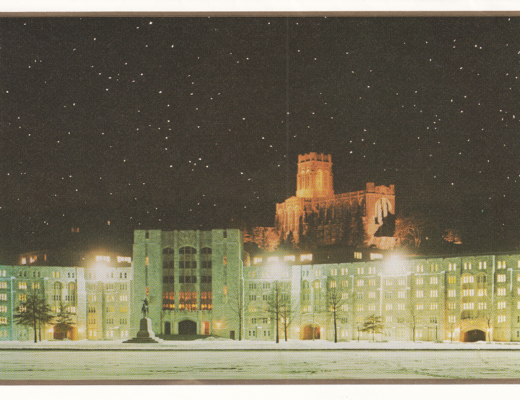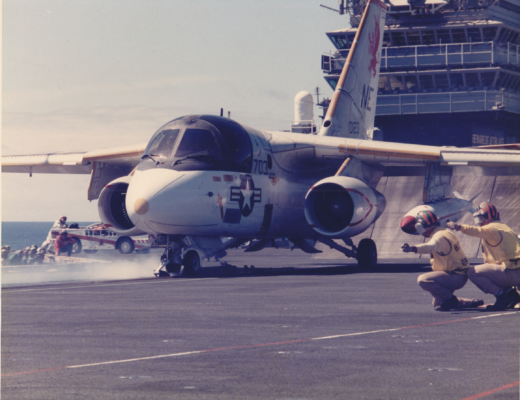Winter 1862-63
Following the wide-ranging battle along the Charleston and Savannah (C&S) Railroad in October 1862, our ancestor Corporal Julius B. Bell and the Beaufort Volunteer Artillery (BVA) benefited from a quiet winter, during which they likely continued their occasional guerrilla operations against the Federal forces that occupied the South Carolina Sea Islands, the location of the family homes to which most would never return. The artillery unit built pine-log huts in their camp in the woods between McPhersonville and Pocotaligo, and thrilled at reports of a major Confederate victory at Fredericksburg, VA in December.
The Union Gunboat George Washington
Easter was celebrated in the camp and the nearby villages on April 5, 1863. The following Wednesday night Capt. Stephen Elliott led a detachment of artillery units – including all four guns of the BVA under Lt. Henry M. Stuart – down the peninsula between the Coosaw and Combahee Rivers. BVA Pvt. Charles Hutson remembered,“The [Union] gunboat George Washington was known to be in the habit of running up the Combahee River past Chisolm’s Island, and it was planned to get her at that point…. [A]t daydawn our guns were planted on the clay bluff just where the river flows into that noble estuary called the Broad River. Soon the bell aboard the boat sounded the hour, and, as she rode just opposite us, we opened fire. It was not long before we saw she was on fire, with the men aboard her throwing themselves into the water and swimming for dear life for the marshes on the other side…. Some of our men swam out… and somehow managed to get her bell ashore.” 1

The Charleston Mercury reported, “Not a man nor a horse was hurt on our side. The troops returned to their camps on Thursday in excellent spirits, to read the full particulars of the glorious victory in Charleston.2 Of course every body was in a good humor, and satisfied with this week’s experiments in gunboat warfare.”3 In the official records4 Capt. Elliott stated that in addition to the ship’s bell they took a 24-pound brass howitzer, which is said to be the gun on display at the Beaufort Arsenal a century and a half later. Charles Hutson wrote, “We set [the ship’s bell] up in our camp and from that time we used it to ring reveille…..When we retired from the coast at the time of Sherman’s advance from Savannah some of our men buried it. It may be still underground. I have never heard of its being dug up.”1 It is tempting to imagine our ancestor Julius or his nephews John or Ernest Bell ringing that ship’s bell to call their fellow artillerymen to morning muster.
Summer and Fall, 1863
Shortly after the George Washington incident, Capt. Elliott was transferred and assigned to command Fort Sumter in Charleston Harbor. Within a year he had been promoted to Brigadier General and was severely wounded at the Battle of the Crater near Petersburg, Va. on July 30, 1864, wounds that would lead to his death eighteen months later. Nevertheless, Gen. Elliott found the strength to fight alongside the BVA in two last battles in March 1865. He was 35 years-old at his death, and a riverfront park in Beaufort is named in his honor.

Henry M. Stuart, a 27 year-old physician separated by war from his wife and young son, was promoted to Captain and led the BVA for the remainder of the war. The battery apparently settled into a relatively peaceful camp life for about eighteen months. News reached camp of Confederate losses at Vicksburg and Gettysburg, and of a bloody repulse of Union forces at Ft. Wagner near Charleston in July 1863. An historical sketch in the Beaufort Public Library files lists an expedition of elements of the BVA to Barnwell’s Island that same month.
1864
The same source lists a foray to Pinckney’s Island in July of 1864, at which time there would have been trepidation in camp at reports of a large Union force threatening Atlanta. That anxiety increased with the fall of Atlanta in September, and hopes for a politically negotiated peace receded with the reelection of Abraham Lincoln in November. Later that month, accounts of troops led by Gen. William T. Sherman burning a swath through Georgia on the way toward their position should have been alarming, but Charles Hutson remembered that the men were confident and in good spirits.
Honey Hill
The fruitless and bloody charge of African-American troops at Ft. Wagner near Charleston in July 1863, depicted in the 1989 film Glory, was sadly and less famously repeated at the Battle of Honey Hill near the Grahamville depot on the C&S Railroad on November 29 or 30, 1864.
A Confederate officer remembered, “It was known that the yankees [sic]… had been drilling very assiduously for some time, but as the early fall passed without excitement along our extensive picket lines, it became monotonous to all around headquarters…. On the morning of [Nov] 29th, a picket from Boyd’s landing came dashing up with intelligence that the enemy were coming up Boyd’s creek with a large number of steamers and transports.”5 A force of about 5500 including at least two companies of African-American troops marched toward Grahamville with the intent of cutting the telegraph lines, and destroying or occupying the railroad. Honey Hill, a rocky elevation about two miles east of the depot that commanded the heights above the Grahamville Road, had long been fortified with earthworks and was held by numerous batteries – four guns of which belonged to the BVA – all under the command of Capt. H.M. Stuart. One BVA gun was strategically moved to a possible bypass, and entrenched infantry and cavalry forces supported the artillery in the woods around the hill.

BVA Pvt. C.A. DeSaussure wrote from his perspective on Honey Hill, “Suddenly there burst through the myrtle bushes a battle line of negro troops followed closely by another group in furious charge, all yelling like demons. Captain Stuart waited until they were about 100 yards distant when he sent the full charge of canister from all three guns into their ranks. I’ve seen wheat and oats go down before the scythe or mowing machine, and that is the way the ranks, both first and second, fell before the hail of bullets.”6 As evening drew in it was noted the main body of Union troops “with their wagons, camp equipage, etc. occupied [a] dense broom-grass field.” A scout crawled to the edge of the field and set it afire. In a few minutes, “a roaring mass of flame [was] leaping ten feet high towards the Yankees encamped in the middle… It did not take them long to realize… they must ‘skeedaddle,’ and ‘skeedaddle’ they did…. This defeat at Honey Hill… not only frustrated their attempt to cut the railroad, but saved General [Braxton] Bragg [actually Gen. William Hardee] and his command, for he was at Savannah and if the enemy had occupied Grahamville, as Sherman with his 60,000 was occupying Georgia, his retreat would have been cut off and his capture certain.”6
Fort Coosawhatchie and Mackay’s Point
Pvt. Hutson remembered, “Shortly after this we were put into Fort Coosawatchie to defend… the railway bridge… from gunboats coming up the river from below.”1 A Union battery on a high point across the river shelled the fort constantly, and the BVA took out at least one of these guns. “We “knocked their 20lb Parrot off its carriage and broke up the outfit.”6 Later the BVA returned to Mackay’s Point, six miles south of Pocotaligo. “On Christmas Day we had a lively artillery duel for an hour or so… Several of our men received wounds but none killed.”6 About a month later, the BVA and their accompanying forces would be compelled to abandon the railroad and their fortifications.
Adapted from A String of Bells: Stories of a Southern Family © 2020 by Nick J. Guevara, Jr.
Continued in Part 3
1 C.W. Hutson, “The Beaufort Volunteer Artillery – Experiences of Charles Woodward Hutson” contained in “Records Relating to the BVA,” South Carolina Historical Society, Charleston, S.C. This memoir was written about 1913.
2 A fleet of Ironclad Union monitors unsuccessfully attacked Ft. Sumter on Easter Monday and Tuesday, April 6-7, 1863.
3 Charleston Mercury, Saturday April 11, 1863 pg. 2
4 War of the Rebellion: Serial 020 Page 0283 Chapter XXVI. https://ehistory.osu.edu/books/official-records/020/0283 accessed 27 Oct 2019
5 T.E. Bessillieu in The Savannah Morning News, August 22, 1897 pg 14
6 C.A. DeSuassure “The Story of My Service in the Army of the Confederate States” (1931) contained in “Records Relating to the BVA,” South Carolina Historical Society, Charleston, S.C.





No Comments